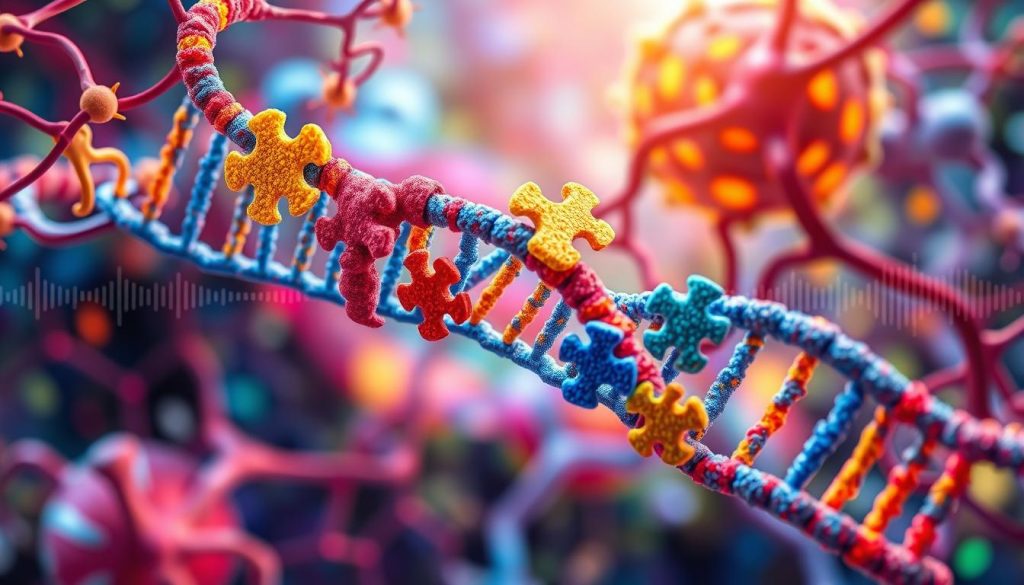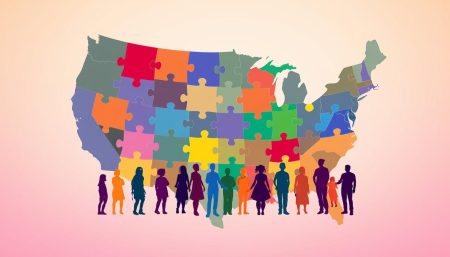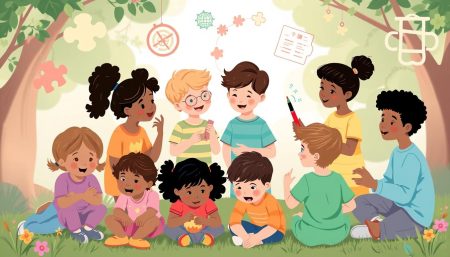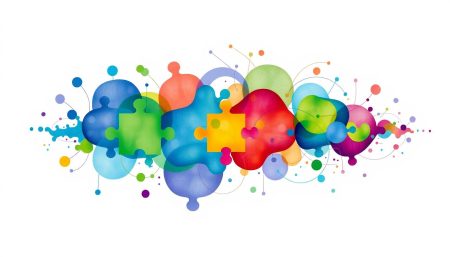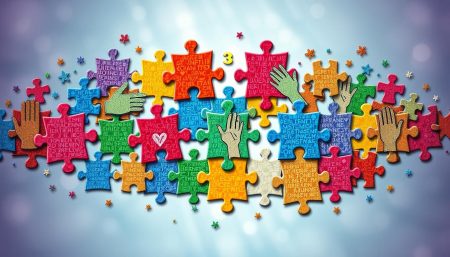Autism spectrum disorder (ASD) is a complex condition that affects many families. The genetics of autism play a key role in its development. Scientists have made great strides in uncovering the autism genetic factors that contribute to this disorder.
Research shows that genes are a key piece of the autism puzzle. While no single gene causes ASD, many genetic variations can increase the risk. Understanding these genetic links helps us grasp why autism runs in some families and how it develops.
As we dive into the world of autism and genetics, we’ll explore the latest findings. This knowledge not only sheds light on the disorder but also paves the way for better support and care for those affected by ASD.
The Genetic Basis of Autism Spectrum Disorder
Autism spectrum disorder (ASD) has a complex genetic foundation. Scientists have made significant strides in understanding the autism genetic causes. They have shed light on the intricacies of autism’s genetic basis.
Understanding Genetic Variations and Mutations
Genetic variations play a key role in ASD development. These DNA changes can be small or large. Some are inherited, while others happen by chance. The genetic basis of autism often involves many genes working together in complex ways.
The Role of DNA in Autism Development
DNA is the blueprint for our bodies, including our brains. Certain genetic changes can affect brain development. This can potentially lead to ASD. Research has found over 100 genes linked to autism risk, showing the disorder’s genetic complexity.
Complex Genetic Patterns in ASD
ASD’s genetic patterns are not simple. Unlike some conditions caused by a single gene, autism involves many genes. This makes it hard to predict autism based on genetics alone. Environmental factors also play a role, adding to the complexity.
| Genetic Factor | Impact on Autism Risk |
|---|---|
| Inherited Variations | Can increase susceptibility |
| Spontaneous Mutations | May directly cause ASD in some cases |
| Gene Interactions | Influence severity and symptoms |
Understanding the genetic basis of autism is key for early diagnosis and treatment. As research advances, our knowledge of autism genetic causes grows. This offers hope for better treatments and support for those with ASD.
Is Autism Genetic: Exploring the Scientific Evidence
Research has made big steps in understanding autism’s genetic roots. Studies show that genes play a key role in autism.
Twin studies offer strong evidence. Identical twins, sharing all genes, are more likely to both have autism. Fraternal twins, sharing half, are less likely. This shows a strong genetic link to autism.
Many genes linked to autism risk have been found. These genes affect brain development and how neurons talk to each other. Finding these genes helps answer if autism is genetic.
Genomic studies have found both common and rare genetic variants in autism. Common variants are common in everyone but more in those with autism. Rare variants, like copy number variations, have a bigger impact.
| Genetic Factor | Impact on Autism Risk |
|---|---|
| Common Variants | Moderate increase |
| Rare Variants | Substantial increase |
| De Novo Mutations | Significant increase |
Genetics are important, but environment also plays a part in autism. Research is ongoing to understand how genes and environment interact in autism.
Hereditary Factors in Autism Development
Research has shown that autism has a strong genetic link. Scientists have found that genes play a big role in autism.
Family History and Autism Risk
Studies reveal that a family history of autism raises a child’s risk. If one child has autism, the chance of another child having it is 2-18%. This shows a clear genetic link to autism.
Twin Studies and Genetic Links
Twin studies are key in understanding autism’s genetics. Identical twins, who share all their genes, have a much higher chance of both having autism. This proves that genetics are a big factor in autism.
| Twin Type | Concordance Rate |
|---|---|
| Identical Twins | 60-90% |
| Fraternal Twins | 0-30% |
Sibling Risk Factors
Siblings of kids with autism face a higher risk. This risk is higher than in the general population. Studies suggest that younger siblings have a 3-18% chance of autism.
Knowing about these genetic factors is vital for families with autism. It aids in early detection and better care. This improves the lives of those with autism spectrum disorders.
Environmental Factors vs. Genetic Predisposition
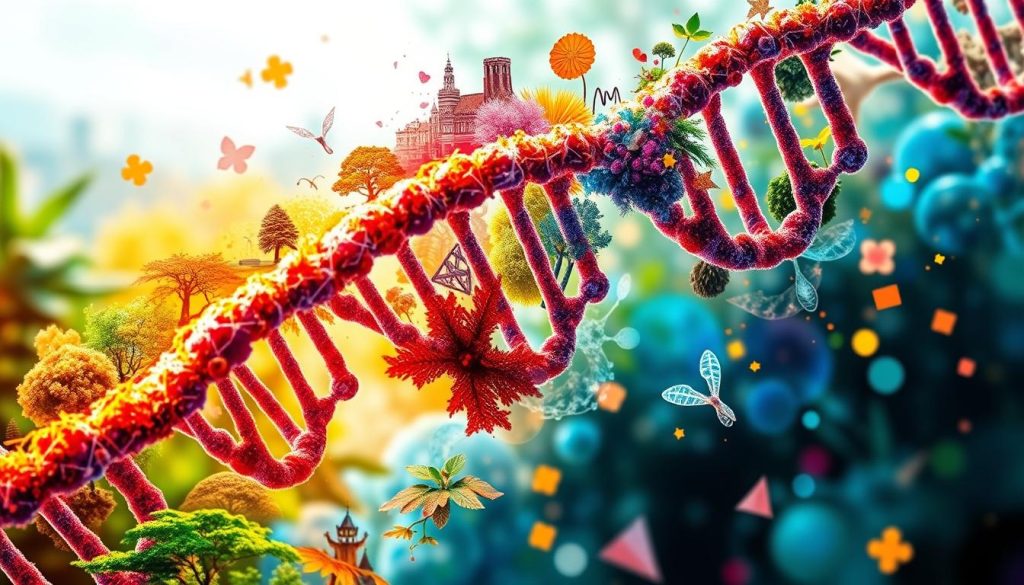
The debate on autism spectrum disorder (ASD) is ongoing. It focuses on whether genes or environment play a bigger role. Autism genetic risks are significant, but environmental factors also matter.
Research indicates that genes are responsible for about 80% of ASD risk. This shows a strong genetic link. But, the remaining 20% suggests that environment can also play a part in triggering or worsening ASD symptoms.
Several environmental factors have been linked to a higher risk of ASD. These include:
- Advanced parental age
- Maternal infections during pregnancy
- Exposure to certain medications or toxins
- Complications during birth
The relationship between genes and environment is complex. A child with a high risk of autism may not develop it without certain environmental triggers. On the other hand, environment alone rarely causes autism without a genetic predisposition.
It’s important to understand how genes and environment interact. This knowledge is key to creating better prevention and treatment plans for ASD. Future studies aim to explore how specific environmental factors affect genetic predispositions. This could lead to more tailored treatments for those with ASD.
Understanding Autism Gene Mutations
The genetics of autism are key to understanding the disorder. Scientists have found many gene mutations linked to autism spectrum disorder (ASD). These mutations can change how the brain grows and works.
Common Genetic Variants
Many people have common genetic variants that slightly raise their risk of autism. These variations are common but more often found in those with ASD. While one variant alone might not cause autism, many together can.
Rare Genetic Changes
Some autism cases come from rare genetic changes. These mutations can greatly affect brain development. They often impact genes that help with cell communication or forming connections between brain cells. Finding these rare changes helps researchers understand autism better.
De Novo Mutations
De novo mutations are new genetic changes that happen by chance. They are not passed down from parents but occur in the egg, sperm, or early embryo. These mutations can greatly increase the risk of autism. Studies show they are more common in families with only one child with ASD.
Understanding these different mutations is essential to understanding autism’s complex genetics. It helps explain why autism can vary so much and why it sometimes runs in families. This knowledge is important for creating better diagnostic tools and treatments for ASD.
The Role of Genetic Testing in Autism Diagnosis
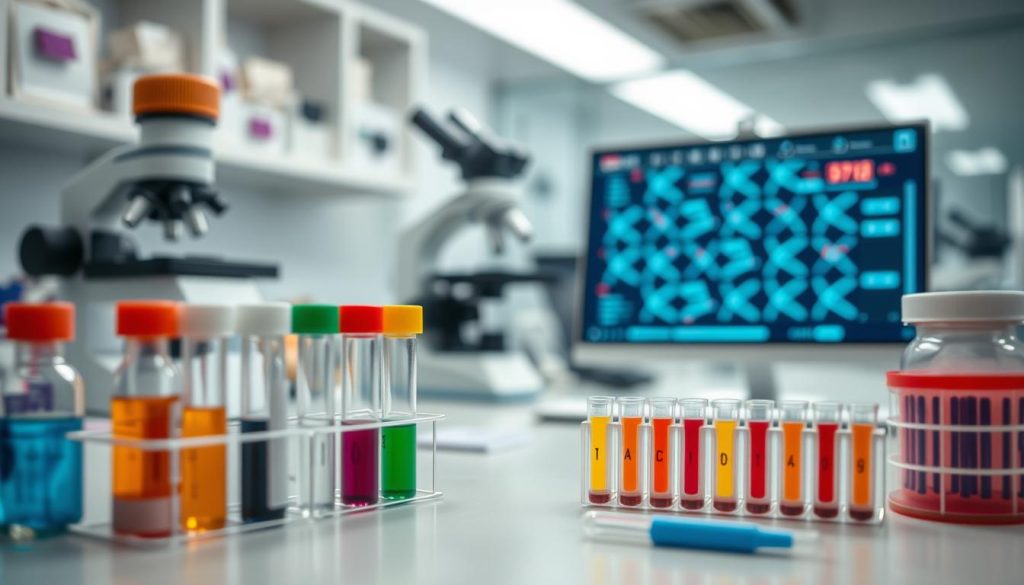
Genetic testing is key in understanding autism genetic causes. As scientists learn more, these tests help diagnose and treat autism early.
There are several types of genetic tests for autism spectrum disorder:
- Chromosomal Microarray Analysis (CMA)
- Whole Exome Sequencing (WES)
- Fragile X Testing
- Specific Gene Panel Testing
CMA is often the first test for autism. It finds big chromosomal changes linked to ASD. WES looks at all protein-coding genes and finds smaller changes.
Genetic testing helps families understand autism in their loved ones. It guides treatment and informs future pregnancy decisions. But, a negative test doesn’t mean someone can’t have autism. The genetic basis of autism is complex and not fully understood.
As research grows, genetic testing for autism gets better. New findings about autism genetic causes lead to better diagnostic tools and therapies. This progress brings hope for better lives for those on the autism spectrum.
Autism Heritability Patterns and Research
Recent studies have focused on the heritability of autism. Scientists are learning more about how autism spectrum disorder (ASD) is passed down in families. They are also exploring its genetic links.
Latest Research Findings
A groundbreaking study by UCLA Health has made significant discoveries. It found seven genes that might raise the risk of ASD. The study also found that rare inherited changes play a big role in the disorder.
Statistical Data on Inheritance
Recent data points to a strong genetic link in autism. If one identical twin has ASD, the other twin has a 60-90% chance of being diagnosed too. For non-identical twins, the risk is about 10%.
| Relationship | Risk of ASD |
|---|---|
| Identical Twin | 60-90% |
| Non-identical Twin | ~10% |
| Sibling | 3-14% |
Population Studies
Large-scale studies have shown that autism’s heritability is between 50-90%. These findings highlight the complex genetics of ASD. They also show the need for more research to understand its inheritance patterns.
Gene-Environment Interactions in Autism
Autism’s development is a mix of genetics and environment. Studies show that certain environmental factors can trigger or boost autism’s genetic risk. This mix is key in understanding autism’s genetic risks.
Researchers have found several environmental factors that can raise the chance of autism. These include infections in the mother during pregnancy, exposure to some chemicals, and older parents. The timing of these exposures is very important, with the prenatal period being the most sensitive.
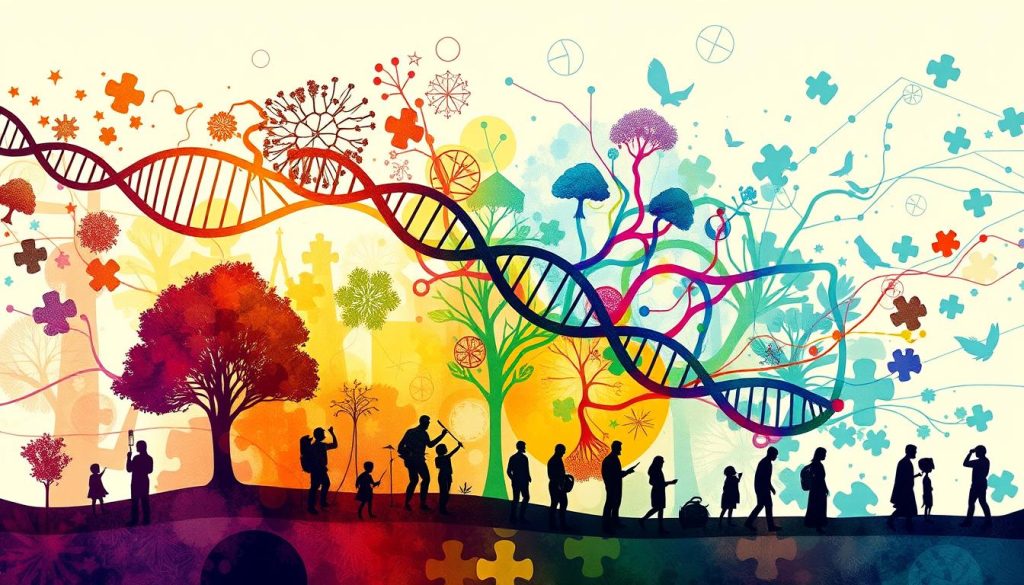
Studies show that people with certain genes might be more affected by environmental triggers. For example, kids with autism-related genes might be more impacted by air pollution or stress in the womb. This shows why we need to look at both genetics and environment when talking about autism risk.
| Environmental Factor | Potential Impact on Autism Risk |
|---|---|
| Maternal Infections | May increase risk in genetically susceptible individuals |
| Air Pollution | Can amplify effects of certain autism-related genes |
| Maternal Stress | May interact with genetic predisposition to ASD |
| Parental Age | Advanced age associated with higher autism genetic risks |
Understanding how genes and environment interact is key for better prevention and treatment. More research could lead to better ways to manage autism risks and improve life for those with ASD.
Understanding Autism Risk Factors During Pregnancy
Pregnancy is a key time for a baby’s growth. Scientists are finding links between autism and prenatal conditions. This info helps families understand autism risks.
Maternal Age Impact
Studies show maternal age affects autism risk. Women over 35 are more likely to have a child with autism. This might be because older eggs have more genetic mutations.
Prenatal Environmental Exposures
The environment in pregnancy can impact autism risk. Exposure to chemicals, medications, or infections can affect brain development. Air pollution and stress are also being studied for their effects.
Genetic Screening During Pregnancy
Genetic screening tests can spot some autism risks. These tests look for genetic changes linked to autism. While not perfect, they offer important insights for parents and doctors.
| Risk Factor | Impact on Autism Risk | Screening Available |
|---|---|---|
| Advanced Maternal Age | Increased | Yes |
| Prenatal Infections | Potential Increase | Limited |
| Genetic Mutations | Significant | Yes |
Knowing these risk factors helps families and doctors watch over fetal development. While genetics are important, many children exposed to these risks don’t get autism.
Breaking Down Complex Genetic Inheritance in ASD
Understanding autism’s genetics is like solving a puzzle. Autism spectrum disorder (ASD) doesn’t follow simple patterns. It involves a mix of genetic factors that work together in unique ways.
Genes are key in autism development. Scientists have found hundreds of genes linked to ASD risk. Some changes come from parents, while others happen on their own. This makes it hard to predict autism inheritance in families.
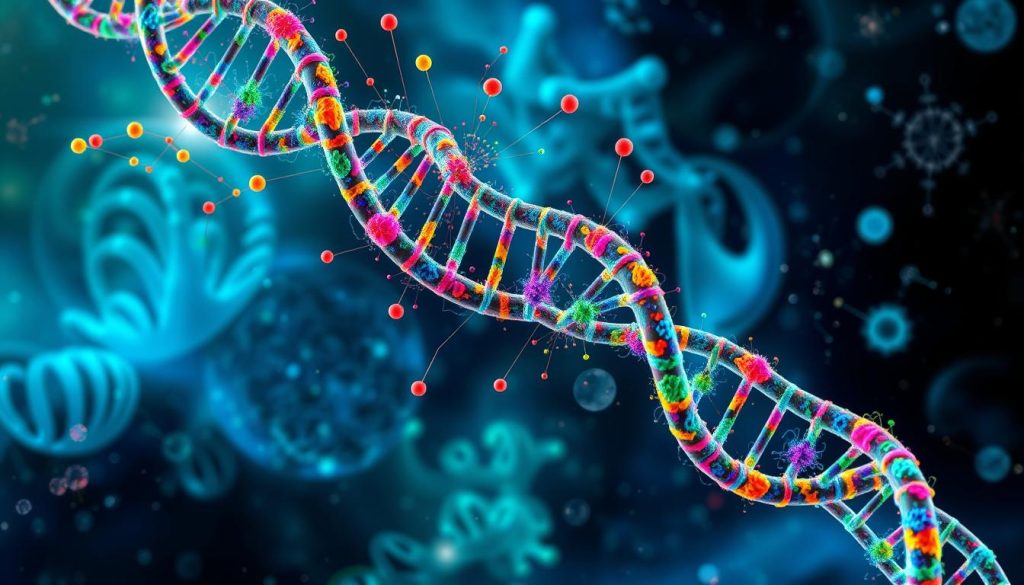
- Polygenic inheritance: Multiple genes contribute to autism risk
- De novo mutations: New genetic changes not present in parents
- Copy number variations: Large sections of DNA are duplicated or deleted
- Epigenetic factors: Environmental influences on gene expression
The mix of these factors creates a unique genetic profile for each person with autism. This complexity explains why autism can vary greatly in its presentation and severity among individuals.
| Inheritance Type | Description | Impact on ASD Risk |
|---|---|---|
| Polygenic | Multiple genes involved | Cumulative effect increases risk |
| De novo mutations | New genetic changes | Can significantly increase risk |
| Copy number variations | Large DNA changes | May cause or contribute to ASD |
| Epigenetic factors | Gene expression changes | Can modify ASD risk or symptoms |
As research goes on, we learn more about autism’s genetic complexities. This knowledge is key for better diagnostic tools and treatments for ASD.
Latest Advances in Autism Genetic Research
The field of autism genetic research is moving fast. Scientists are learning more about the genetic causes of autism. This knowledge brings hope for better diagnosis and treatment.
Current Studies and Findings
Recent studies have found over 100 genes linked to autism. Researchers are studying how these genes work together. They’ve found that de novo mutations, which happen on their own, play a big role.
Future Research Directions
Future studies will look at how genes and environment interact in autism. Scientists will study epigenetic changes, which affect gene expression. This could help explain why autism affects people differently.
Promising Therapeutic Approaches
Genetic research is leading to new treatments. Researchers are working on gene therapy and personalized medicine. These could lead to treatments that work better for each person’s genetic makeup.
| Research Area | Potential Impact |
|---|---|
| Gene-environment interactions | Better understanding of autism risk factors |
| Epigenetic studies | Insight into variable autism expression |
| Personalized medicine | Tailored treatments based on genetic profiles |
As research goes on, we learn more about autism’s genetic roots. These findings help us get closer to solving the puzzle of autism. They also lead to better ways to help those affected.
Genetic Counseling for Families Affected by Autism
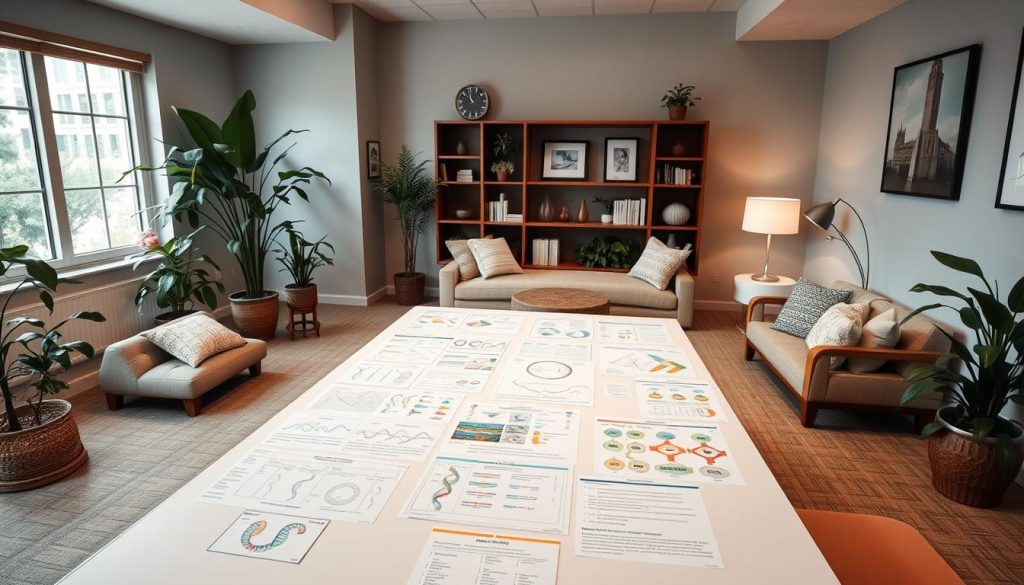
Families dealing with autism often wonder about its genetic risks. Genetic counseling offers support and guidance. It helps families understand the complex genetics of autism.
Genetic counselors do many things during sessions. They:
- Analyze family medical histories
- Explain genetic testing options
- Interpret test results
- Discuss possible inheritance patterns
- Address concerns about future pregnancies
Genetic counseling helps families make informed decisions. It provides personalized risk assessments. This way, parents can understand their child’s genetic profile better.
For families thinking about more children, counseling is key. It clarifies the chance of autism in future kids. This helps parents prepare emotionally and financially.
Genetic counseling also connects families with resources and support. It helps parents find therapies that fit their child’s genetic needs. This can make a big difference in their child’s life.
Implications of Genetic Understanding for Treatment
Our growing knowledge of autism genetic predisposition is opening new doors for treatment. Doctors can now tailor therapies to each person’s unique needs. This approach, called precision medicine, aims to make treatments more effective.
Researchers are exploring gene-targeted therapies for autism. These treatments focus on specific genes linked to autism symptoms. While it’s early, this research shows promise for future autism care. It could lead to more personalized and effective interventions.
The future of autism treatment looks bright thanks to genetic insights. As we learn more about autism genetic links, we can develop better tools for early diagnosis. This early detection allows for quicker intervention, which often leads to better outcomes. With continued research, we hope to see even more advances in autism care based on genetic understanding.
FAQ
Q: Is autism purely genetic?
A: No, autism is not just about genes. While genes are a big part of it, other factors also play a role. Studies say genes are responsible for about 80% of autism risk. But, environmental factors also help shape it.
Q: Can autism be inherited from parents?
A: Yes, autism can be passed down from parents. Studies show that having a family member with ASD increases a child’s risk. But, it’s not simple. It’s a complex mix of genetics and environment.
Q: Are there specific genes linked to autism?
A: Yes, many genes are linked to autism. These include common and rare mutations. Genes like SHANK3, CHD8, and PTEN are often mentioned. But, no single gene causes all autism cases. It’s usually a mix of many genes.
Q: How accurate is genetic testing for autism?
A: Genetic tests for autism can be helpful but not perfect. They can spot known mutations in 10-20% of cases. These tests help understand genetic factors but aren’t a final diagnosis.
Q: Can environmental factors override genetic predisposition to autism?
A: Environmental factors can affect autism risk, but they can’t change genes. Instead, they can change how genes work. This is called gene-environment interaction.
Q: What are de novo mutations in autism?
A: De novo mutations are new genetic changes in a child. They’re not in either parent’s DNA. These changes can increase autism risk. They’re common in ASD cases without family history.
Q: How does maternal age affect autism risk?
A: Older mothers have a slightly higher risk of having a child with autism. This might be because older eggs have more genetic mutations. But, most children born to older mothers don’t have ASD.
Q: What is the heritability of autism?
A: Autism’s heritability is about 80%. This means 80% of autism risk comes from genetics. But, genetics alone don’t cause autism. Environment also plays a part.
Q: Can genetic counseling help families affected by autism?
A: Yes, genetic counseling helps families with autism. It explains the genetic side of ASD and helps with family planning. Counselors also discuss genetic tests and their results, guiding families through autism genetics.
Q: How might understanding autism genetics lead to new treatments?
A: Knowing autism’s genetics could lead to better treatments. Researchers might find gene-targeted therapies. This could mean more effective treatments tailored to each person’s genetic makeup, moving towards precision medicine in autism.












